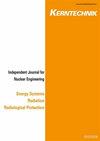确保新的、先进的小型模块化反应堆的安全,确保基本安全,并具有最佳的主热传输系统配置
IF 0.4
4区 工程技术
Q4 NUCLEAR SCIENCE & TECHNOLOGY
引用次数: 0
摘要
许多国家正在考虑将小型和模块化反应堆作为应对气候变化/全球变暖的可行替代方案,并在能源结构中快速部署绿色,无碳的核能选择。smr的支持者声称,这些设计更多地依赖于增强的固有/工程安全性和具有新颖概念的被动特性。smr被设计为在工厂制造,然后作为“模块”运输到现场,作为单个模块或多个模块工厂安装。有许多不同的小型反应堆正在考虑/设计/建造/调试/运行状态,其中大多数,70多个小型反应堆处于设计阶段。本文的重点是安全方面,同时解决了从基本安全原则、验收标准、预期/设想的安全目标衍生出来的基本安全要求,而不仅仅是经济影响/考虑。针对所提出的要求,强调了安全增强要求的评估基础及其在设计中的保证程度。确保SMR在基本安全功能方面的安全将取决于在最坏/可信的事故条件下,燃料过热后裂变产物的可预见/预测释放,以及这些事故发生的可能性。先进燃料开发的创新、被动安全系统的部署、主要热传输系统配置的新概念以及仪器仪表的先进功能,可以帮助实现确保smr在严重事故期间在预防和缓解领域增强安全性的目标。验收标准以及确定性和概率性安全目标的改进也是可以预期和设想的。本文提出了新核电站在设计和监管方面面临的挑战,同时解决了基本安全原则的实施、通用的、具体的安全问题,以及只有真正的创新才能确保和提高安全性。本文还讨论了非能动系统和核电厂主排热系统的最佳配置。本文还提出了包括小堆在内的新型核电站并行设计和管理的有关问题。本文章由计算机程序翻译,如有差异,请以英文原文为准。
Ensuring safety of new, advanced small modular reactors for fundamental safety and with an optimal main heat transport systems configuration
Abstract Many countries are considering Small and Modular Reactors as a viable alternative to counter the climate-change/global-warming with a quick deployment of green, carbon free nuclear energy option in the energy mix. Proponents of SMRs claim that these designs rely more on enhanced inherent/engineered safety and passive features with novel concepts. SMRs are being designed to be fabricated at a factory and then transported as ‘modules’ to the sites for installation either as a single module or multiple module plant. There are many variant of SMRs under considerations/design/construction/commissioning/operation states and majority of the, more than 70 odd SMRs are in the design stage. The paper focuses on safety aspects while addressing the fundamental safety requirement that are derived from fundamental safety principles, the acceptance criteria, the expected/envisaged safety targets and not only the economic impact/considerations. The assessment basis for requirements towards safety enhancements and their extent of assurance in the design are highlighted against the claims made. Ensuring SMR safety with respect to the fundamental safety functions will depend on the foreseen/predicted fission product releases, following overheating of the fuel, during the worst/credible accident conditions and likelihood of occurrence of these accidents. Innovations in the development of advanced fuel, deploying passive safety systems, novel concepts in main heat transport system configuration and advanced features in instrumentation can help in realising the goal of ensured enhanced safety in the SMRs, both in preventive and mitigation domains during severe accidents. Enhancements in the acceptance criteria and deterministic and probabilistic safety targets is also expected and may be envisaged. The paper brings out the challenges faced in the design and regulation of the new NPPs, while addressing fundamental safety principles implementation, generic, specific safety issues, and only genuine innovations can ensure and improve the safety. Aspects related to passive systems and the optimal main heat removal system configuration of the NPPs are also discussed. The aspects related to concurrent design and regulation of new NPPs including SMRs also has been brought out in the paper.
求助全文
通过发布文献求助,成功后即可免费获取论文全文。
去求助
来源期刊

Kerntechnik
工程技术-核科学技术
CiteScore
0.90
自引率
20.00%
发文量
72
审稿时长
6-12 weeks
期刊介绍:
Kerntechnik is an independent journal for nuclear engineering (including design, operation, safety and economics of nuclear power stations, research reactors and simulators), energy systems, radiation (ionizing radiation in industry, medicine and research) and radiological protection (biological effects of ionizing radiation, the system of protection for occupational, medical and public exposures, the assessment of doses, operational protection and safety programs, management of radioactive wastes, decommissioning and regulatory requirements).
 求助内容:
求助内容: 应助结果提醒方式:
应助结果提醒方式:


